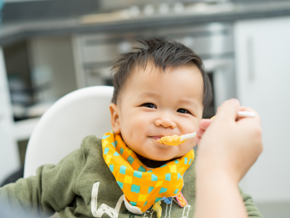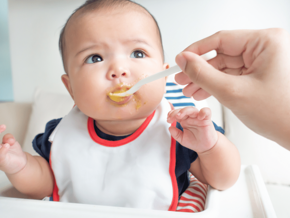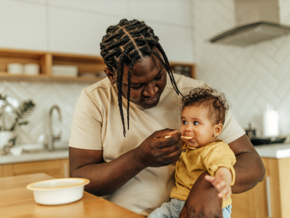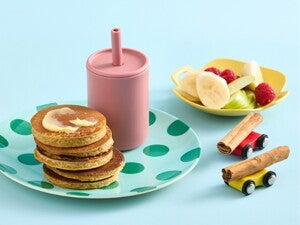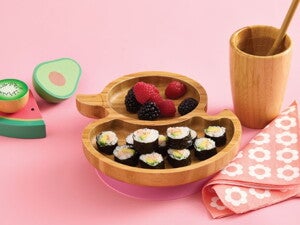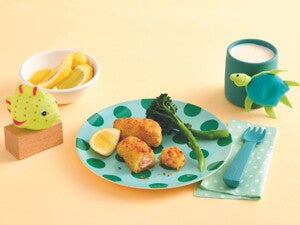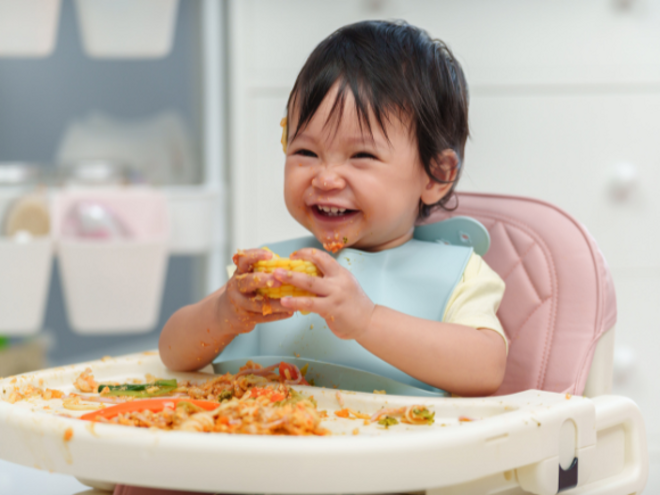
Baby led weaning skips the puree stage and simply jumps to the finger food stage. This allows your baby to pick up, touch and play, smell, and taste the usual family foods – such as a thick finger piece of steak, a thick finger piece of soft vegetable, a piece of mango, banana or avocado. While the definition of baby led weaning is to skip the traditional stages of solids (puree, mashed), you can choose to combine some puree foods with finger foods to suit your baby. During the start of their solids journey your baby will still be receiving most of their nutrient intake from breastmilk or formula.
When to start baby led weaning
The ideal time to start finger food is when your baby is picking up anything and everything and putting it in their mouth. It is a clear indicator that they are searching for food. Babies also love to copy their older siblings or parents and enjoy being part of mealtimes with the ability to demonstrate independence with their eating. As all babies develop at different paces, if you are unsure whether it’s safe to commence finger foods with your little one, talk to your healthcare professional
Sometimes this is started by accident especially with subsequent children, as babies love to grab food off their older sibling’s plate. However, ideally this is started at a family mealtime. When your baby is around 6 months of age you should start introducing solid foods, keep an eye out for signs of readiness.
How to start baby led weaning
Start with seating your baby in a highchair at mealtimes when they are able to sit upright with minimal support. When your baby starts showing signs they would like to join in the meal time, simply start with offering suitable foods such as a softly cooked piece of vegetable off your plate. Stable plates and bowls with large openings make picking up foods with fingers even easier. Don’t worry about how messy finger-feeding can be, it’s all part of the journey. BLW helps develop motor skills, particularly hand-eye coordination, and it makes your little one feel more independent.
Other tips for starting baby led weaning include:
- Offering small bite-sized pieces of soft-cooked vegetables or soft fruits, like ripe banana pieces.
- Choosing textures that dissolve quickly in the mouth, like grain snacks or yoghurt.
- Selecting foods that are easy to pick up, like well-cooked pasta pieces
- Avoiding foods that could be swallowed whole that put your child at risk of choking.
Babies still have small tummies, so mini-meals or small meals and snacks can work well. Snacks play an important role in a healthy diet, and with all sorts of different shapes and sizes to choose from, can help them master self-feeding. Since this is when your baby learns to mash and chew, start with snacks that dissolve easily. When your little one starts to get the hang of them, try more textured snacks. Introducing solid foods is not always easy, for fussy eaters you may need to be more imaginative with the variety of foods you introduce. One of the benefits of baby led weaning is that it allows your baby the chance to handle and play with their food which may help them get comfortable with new foods and textures.

Popular BLW foods to try with your baby
Many BLW first foods have a built-in handle – like a piece of cauliflower or broccoli, a cooked piece of carrot in the shape of a chip or even a little chop to suck on. At first, they might just play with the food, smell it, look at it and then start to suck on it.
It’s advised to also give them soft textured foods as well, especially iron rich foods as babies’ iron stores do start decreasing from birth until they are restored through iron rich foods when solids are introduced. So iron enriched infant cereal, meat and vegetables and mashed foods can still be offered on a spoon, and a variety of textures, colours, temperatures all to follow.
Here are some popular BLW foods you can try with your little one when they are ready:
Fruit for BLW
- Banana (ripe and cut into strips)
- Avocado (sliced or mashed)
- Pear (ripe and cut into wedges)
- Peaches (sliced and soft)
- Watermelon (seedless and cut into sticks)
Proteins for BLW
- Chicken (cooked and shredded or in strips)
- Fish (boneless, cooked, and flaked)
- Tofu (soft and cut into cubes)
- Eggs (scrambled or hard-boiled, cut into wedges)
Vegetables for BLW
- Sweet potato (cooked and cut into sticks)
- Carrots (steamed and cut into sticks)
- Broccoli (steamed and cut into florets)
- Zucchini (cooked and cut into sticks)
- Cauliflower (steamed and cut into florets)
Whole grains for BLW
- Oatmeal or porridge (made thick and served with a spoon)
- Bread (whole grain, crusts removed, cut into strips)
- Pasta (cooked and cut into manageable pieces)
- Rice (cooked well)
Dairy for BLW
- Yoghurt (plain, served with a soft spoon)
- Cheese (soft cheese cut into sticks)
BLW doesn’t mean weaning away from breastfeeding
It is important to note that baby led weaning has nothing to do with your infant weaning from the breast. Breast milk or formula continues to be an important source of nutrition for your baby. If you do decide to wean from breastfeeding completely before 12 months, a suitable infant formula needs to be introduced.
Is the mess from baby led weaning worth it?
All methods of feeding babies are a messy exercise, and BLW may increase this mess, but it is important for babies to feel the texture of foods and explore foods. Just as playing with toys, paints and dirt, are all messy exercises, they are an important part of growing and developing. Here are some tips to make the setup and cleanup after baby led weaning easier for parents:
Set up for BLW
- Choose a designated eating area: Use a high chair or a specific spot at the table to contain messes.
- Use a bib: Opt for a large, wipeable bib to catch spills and food.
- Place a mat underneath: Use a silicone mat or a large cloth under the high chair to catch dropped food.
- Prepare food in advance: Pre-cut fruits and vegetables and store them in the fridge for quick access.
- Keep utensils accessible: Have baby-friendly utensils and plates within reach for easy serving.
- Limit distractions: Ensure the eating area is calm and free from distractions to help the baby focus on eating.
Clean up after BLW
- Use a wet cloth: Keep a damp cloth or wipes handy for quick cleanups during the meal.
- Soak dishes immediately: Soak bowls and utensils right after the meal to make cleaning easier later.
- Vacuum or sweep after meals: Use a handheld vacuum or broom to quickly clean up food from the floor.
- Involve your child: When they’re older, encourage your little one to help with cleanup by handing them a damp cloth to wipe the table or high chair.
- Establish a routine: Create a consistent cleanup routine to make it easier to manage post-meal messes.
- Use easy-to-clean materials: Choose high chair and table materials that are easy to wipe down and resistant to stains.
Implementing these strategies can help streamline the process of feeding and cleaning up after baby-led weaning, making it a more enjoyable experience for both parents and babies.
What are the benefits of baby led weaning?
There is much debate about blw benefits and whether they outweigh the limitations. Some of the benefits may include:
- Improves enjoyment of food: Encourages a positive relationship with food by allowing babies to explore and enjoy different tastes and textures.
- Increases variety of accepted foods: Exposes babies to a wider range of foods, which may lead to greater acceptance of various flavours and textures.
- Enhances self-feeding ability: Promotes independence and self-regulation as babies learn to feed themselves at their own pace.
- Develops fine motor skills: Encourages the use of hands and fingers to grasp and manipulate food, which aids in fine motor skill development.
- Sparks curiosity for new foods: Engages babies’ natural curiosity about food, encouraging them to try new items and flavours.
- Encourages family meals: Allows babies to participate in family meals, fostering social interaction and shared experiences during mealtime.
- Supports oral development: Encourages chewing and the development of oral motor skills, which can be beneficial for speech development.
What are the limitations of baby led weaning?
After considering blw benefits, it is essential to consider the limitations of baby led weaning and consult with healthcare professionals to ensure a balanced approach to introducing solids. Limitations of baby led weaning may include:
- A real risk of choking – babies should never be left unsupervised while eating;
- Development of eating and speech being affected due to skipping through the puree stage; and
- Adequate nutritional intake may be impacted as too much emphasis is placed on food being for play up until 12 months of age. This can especially impact iron intake, which is extremely important for brain development. Breast fed infants in particular need iron-rich foods at around 6 months as stores start depleting from birth.
Australian authorities are yet to provide official recommendations for or against baby led weaning. The Australian Infant Feeding Guidelines continues to recommend starting solids with pureed and well-cooked foods.
Safety tips for trying BLW
When embarking on the journey of baby led weaning (BLW), safety should be a top priority for parents. Always supervise your baby during meals so you can respond quickly to any potential choking hazards. Offer soft, easy-to-grip foods that are appropriately sized to reduce the risk of choking; foods should be cut into manageable pieces, such as strips or wedges. Ensure that your baby is seated upright in a highchair or at the table during feeding to promote safe swallowing and digestion. Additionally, familiarise yourself with basic first aid for choking, and consider taking a first aid course to be prepared for any emergencies.
Signs your baby isn’t ready for starting solids using BLW
Starting baby led weaning (BLW) too soon can negatively impact a baby's proper nutritional intake. If your baby is not developmentally ready and lacks the necessary motor skills or coordination, they may struggle to self-feed. This can result in frustration and a negative association with mealtime and hinder their willingness to explore new foods. Below are some examples of when baby led weaning should be avoided:
- When your baby is not showing signs of readiness for starting solids;
- When your baby has digestive problems such as reflux, tongue tie, palate problems;
- When your baby is developmentally delayed, perhaps due to being born prematurely or with a disability;
- When your baby has special needs and can’t chew very well, or has difficulty picking up foods.
Frequently asked questions about baby led weaning
What is the BLW method?
Baby led weaning is an approach to introducing solid foods where babies are encouraged to self-feed from the start, rather than being spoon-fed purees and progressing through different textures. It involves offering age-appropriate baby finger foods in a safe and supportive environment, allowing babies to explore and develop their feeding skills at their own pace.
When to start baby led weaning?
Wait until your baby is around 6 months of age and showing signs of readiness to eat, such as showing an interest in food, grabbing for food and putting everything in their mouth, being hungry after their usual breast feed or formula feed, and able to sit up with less support.
How to start baby led weaning?
At around 6 months of age, offer age-appropriate iron-rich baby finger foods that are soft and easy to grasp, such as cooked steak strips or fish fingers. Also try soft vegetables, fruits, and well-cooked grains. Allow your baby to self-feed and explore the food independently and always supervise them to prevent choking. Gradually introduce a variety of foods, textures, and flavours, while continuing to breastfeed or provide infant formula as the main source of nutrition. Be patient and allow your baby to progress at their own pace and consult your healthcare professional if you are concerned.
What are the disadvantages of BLW?
The disadvantages of baby led weaning (BLW) might include an increased risk of choking and potential delays in developing essential eating skills as they skip exposure to gradual changes in food texture. Additionally, some parents may find it challenging to ensure their baby receives a balanced diet while self-feeding and therefore may not meet their nutritional needs, particularly of some key nutrients like iron and zinc.
What is the difference between purees and BLW?
The primary difference between BLW vs puree is the approach to introducing solids. Purees involve spoon-feeding smooth, finely blended foods, while BLW encourages self-feeding with whole, soft finger foods. BLW aims to promote independence and exploration of textures, allowing babies to eat at their own pace from the start. Starting with purees allows a baby to move through different food textures at a pace that is safe and supportive of their developmental stage.
Are baby rusks counted as BLW?
Baby rusks can be included in baby led weaning (BLW) as they are typically designed to be easy for babies to hold and chew. However, it is essential to ensure that the rusks are appropriate for your baby's age and developmental stage. Always supervise your baby while eating rusks to prevent choking and ensure they are suitable for your baby's dietary needs.
Do pediatrician's recommend baby led weaning?
Opinions among paediatricians can vary. Your paediatrician will be able to give personalised advice and help you determine whether baby led weaning for your child is the right way to go. They will consider things like your baby’s developmental readiness and whether it’s safe for them. They may also be able to develop an eating plan, or recommend you to a dietitian who can help with a meal plan to ensure your little one is getting enough nutrition to support their growth and development.
Sources:
- Australian Guide to Healthy Eating – Accessed https://www.eatforhealth.gov.au/food-essentials/how-much-do-we-need-each-day/serve-sizes
- Australian Government. Get up and Grow - First foods: food from home. Accessed at: https://www.health.gov.au/sites/default/files/documents/2021/04/first-foods-food-from-home-get-up-and-grow-first-foods-food-from-home.pdf
- Pregnancy, Birth and Baby Website. Accessed at Introducing solid food | Pregnancy Birth and Baby

